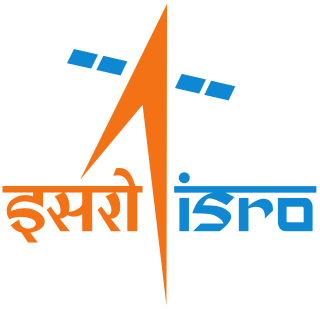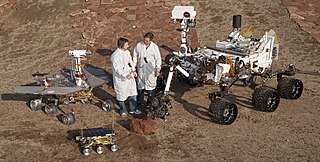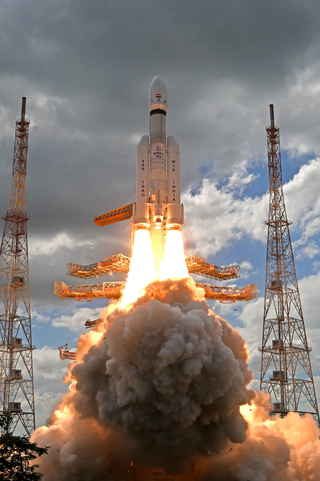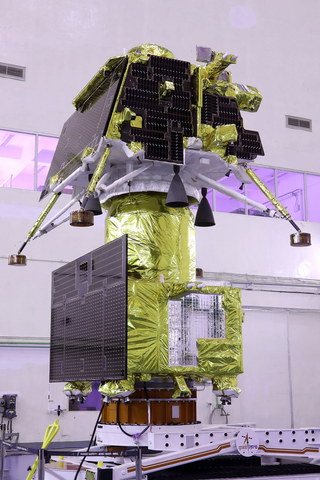Related Research Articles

A lander is a spacecraft that descends towards, then comes to rest on the surface of an astronomical body other than Earth. In contrast to an impact probe, which makes a hard landing that damages or destroys the probe upon reaching the surface, a lander makes a soft landing after which the probe remains functional.

Indian Space Research Organisation is India's national space agency. It serves as the principal research and development arm of the Department of Space (DoS), overseen by the Prime Minister of India, with the Chairman of ISRO also serving as the chief executive of the DoS. It is primarily responsible for space-based operations, space exploration, international space cooperation and the development of related technologies. The agency maintains a constellation of imaging, communication and remote sensing satellites. It operates the GAGAN and IRNSS satellite navigation systems. It has sent three missions to the Moon and one mission to Mars.

Chandrayaan-1 was the first Indian lunar probe under the Chandrayaan programme. It was launched by the Indian Space Research Organisation (ISRO) in October 2008, and operated until August 2009. The mission included an orbiter and an impactor. India launched the spacecraft using a PSLV-XL rocket on 22 October 2008 at 00:52 UTC from Satish Dhawan Space Centre, at Sriharikota, Andhra Pradesh. The mission was a major boost to India's space program, as India researched and developed indigenous technology to explore the Moon. The vehicle was inserted into lunar orbit on 8 November 2008.

A Moon landing or lunar landing is the arrival of a spacecraft on the surface of the Moon, including both crewed and robotic missions. The first human-made object to touch the Moon was Luna 2 in 1959.

A lunar lander or Moon lander is a spacecraft designed to land on the surface of the Moon. As of 2024, the Apollo Lunar Module is the only lunar lander to have ever been used in human spaceflight, completing six lunar landings from 1969 to 1972 during the United States' Apollo Program. Several robotic landers have reached the surface, and some have returned samples to Earth.

A rover is a planetary surface exploration device designed to move over the rough surface of a planet or other planetary mass celestial bodies. Some rovers have been designed as land vehicles to transport members of a human spaceflight crew; others have been partially or fully autonomous robots. Rovers are typically created to land on another planet via a lander-style spacecraft, tasked to collect information about the terrain, and to take crust samples such as dust, soil, rocks, and even liquids. They are essential tools in space exploration.

Indian Deep Space Network (IDSN) is a network of large antennas and communication facilities operated by the Indian Space Research Organisation to support the interplanetary spacecraft missions of India. Its hub is located at Byalalu, Ramanagara in the state of Karnataka in India. It was built under the leadership of S K Shivakumar, the then ISTRAC Director and inaugurated on 17 October 2008 by the former ISRO chairman G. Madhavan Nair.

Chandrayaan-2 is the second lunar exploration mission developed by the Indian Space Research Organisation (ISRO) after Chandrayaan-1. It consists of a lunar orbiter, the Vikram lunar lander, and the Pragyan rover, all of which were developed in India. The main scientific objective is to map and study the variations in lunar surface composition, as well as the location and abundance of lunar water.

The Moon Impact Probe (MIP) developed by the Indian Space Research Organisation (ISRO), India's national space agency, was a lunar probe that was released by ISRO's Chandrayaan-1 lunar remote sensing orbiter which in turn was launched, on 22 October 2008, aboard a modified version of ISRO's Polar Satellite Launch Vehicle. It discovered the presence of water on the Moon.

A lunar rover or Moon rover is a space exploration vehicle designed to move across the surface of the Moon. The Apollo program's Lunar Roving Vehicle was driven on the Moon by members of three American crews, Apollo 15, 16, and 17. Other rovers have been partially or fully autonomous robots, such as the Soviet Union's Lunokhods, Chinese Yutus, Indian Pragyan, and Japan's LEVs. Five countries have had operating rovers on the Moon: the Soviet Union, the United States, China, India, and Japan.

The Chandrayaan programme also known as the Indian Lunar Exploration Programme is an ongoing series of outer space missions by the Indian Space Research Organization (ISRO) for the exploration of the Moon. The program incorporates a lunar orbiter, an impactor, a soft lander and a rover spacecraft.

Jawahar Point or Jawahar Sthal is the site near the Shackleton Crater where the Moon Impact Probe (MIP) of the Chandrayaan-1 hard landed on lunar surface on 14 November 2008. The name was suggested by India's former President A. P. J. Abdul Kalam as the MIP touched the Moon on the birth anniversary of India's first prime minister Jawaharlal Nehru.

Dr. Sreedhara Panicker Somanath is an Indian aerospace engineer serving as the chairman of the Indian Space Research Organisation (ISRO). Under his chairmanship, ISRO carried out the third Indian lunar exploration mission named Chandrayaan-3. The lander named Vikram and the rover named Pragyan landed near the lunar south pole region on 23 August 2023 at 18:04 IST, making India the first country to successfully land a spacecraft near the lunar south pole and the fourth country to demonstrate soft landing on the Moon. This landing gained India a proud history.

Pragyan is a lunar rover that forms part of Chandrayaan-3, a lunar mission developed by the Indian Space Research Organisation (ISRO).

Chandrayaan-3 is the third mission in the Chandrayaan programme, a series of lunar-exploration missions developed by the Indian Space Research Organisation (ISRO). The mission consists of a Vikram lunar lander and a Pragyan lunar rover was launched from Satish Dhawan Space Centre on 14 July 2023. The spacecraft entered lunar orbit on 5 August, and India became the first country to touch down near the lunar south pole, at 69°S, the southernmost lunar landing on 23 August 2023 at 18:04 IST, ISRO became the first agency to land on the south pole of the moon in its first attempt and overall the fourth space agency to successfully land on the Moon, after USSR, NASA and the CNSA.

Chandrayaan-4 is a planned lunar sample return mission of the Indian Space Research Organisation (ISRO) and the fourth iteration in its Chandrayaan lunar exploration programme. The mission is currently under conceptualization and expected to launch around 2027. It is planned to return up to 3 kg (6.6 lb) of lunar regolith from near Statio Shiv Shakti, the landing site of Chandrayaan-3.
Shivashakti or Sivasakthi is a compound name in which Shiva is the identified masculine consciousness and Shakti is the identified feminine divine energy. It may refer to:

Statio Shiv Shakti or Shiv Shakti Point is the landing site of Chandrayaan-3, the third lunar mission of Indian Space Research Organisation (ISRO). The mission's lander Vikram and rover Pragyan landed 600 km from the south pole of the Moon on 23 August 2023. The landing site was named on 26 August 2023 at the ISTRAC headquarters in Bengaluru, after India became the fourth nation to make a successful soft landing on the Moon and also becoming the first country that landed on the lunar south pole. Statio Shiv Shakti is located at the coordinates 69.373°S 32.319°E and lies between the lunar craters Manzinus C and Simpelius N. It has been proposed that the upcoming sample-return mission Chandrayaan-4 also land near the point.

Pragyan is a lunar rover that forms part of Chandrayaan-2, a lunar mission developed by the Indian Space Research Organisation (ISRO). The rover was launched as part of Chandrayaan-2 on 22 July 2019 and was destroyed with its lander, Vikram, when it crashed on the Moon on 6 September 2019.
References
- ↑ "Modi in Bengaluru Live Updates: Touchdown point of Vikram lander will be known as 'Shivshakti', says PM". The Indian Express. 2023-08-25. Retrieved 2023-08-26.
- ↑ "Mission homepage". Indian Space Research Organisation.
- ↑ "Chandrayan-2 Launch Rescheduled on 22 July 2019, AT 14:43 HRS". Indian Space Research Organisation. 18 July 2019. Archived from the original on 30 August 2019. Retrieved 18 July 2019.
- ↑ "Tiranga and Shiv Shakti: India names two areas on Moon related to Chandrayaan missions". ABP News. 26 August 2023. Retrieved 27 August 2023.
- ↑ "Chandrayaan 3 touchdown spot named 'Shiv Shakti', 'Tiranga' for Chandrayaan 2". Hindustan Times. 26 August 2023. Retrieved 27 August 2023.
